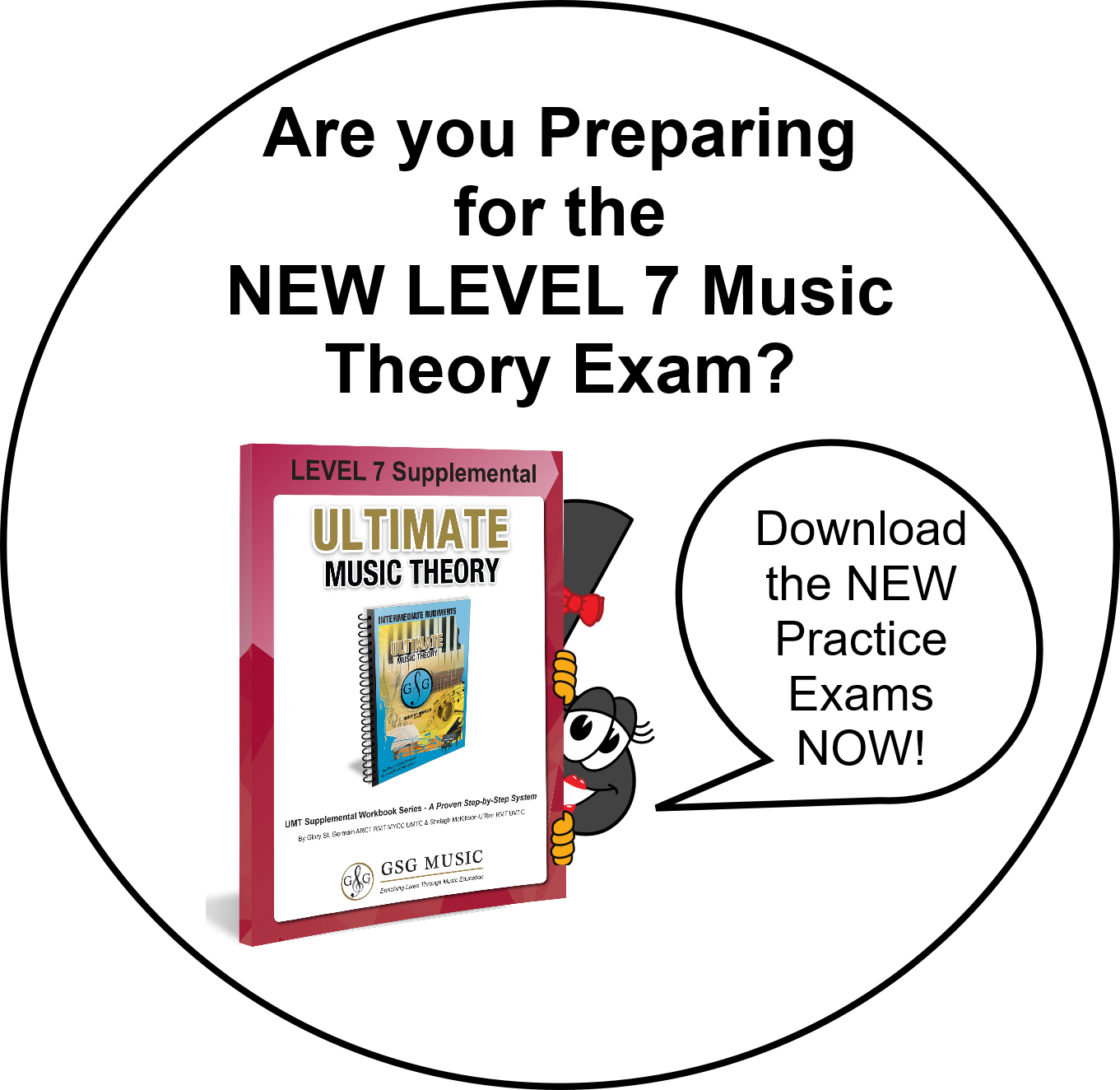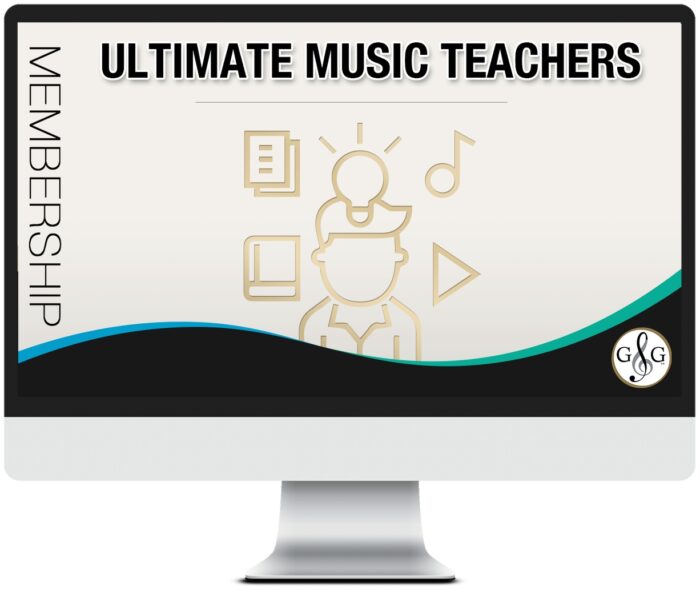Level 7 Music Theory Exam

The Level 7 Music Theory Exam is the "new" Theory Exam. This Theory Level covers concepts in between the Intermediate (Level 6) and the Advanced (Level 8) Rudiments Levels.
The 2016 RCM Theory Syllabus has combined the “Theory” components of the (previous) Preparatory, Basic, Intermediate and Advanced Rudiments with the Language of Harmony and History (formerly the Level 3 History and Harmony levels).
In the Level 7 Music Theory Exam, Students are required to identify Non-Chord Tones (Passing Tones and Neighbor Tones) when they are analyzing melodies. They also need to know Irregular Groups of notes.
In this Blog, we will explore how to easily teach these new Harmony Concepts and how to easily prepare for the NEW Level 7 Music Theory Exam!.
LEVEL 7 Music Theory Exam - New Concept: Passing Tones and Neighbor Tones
When writing or analyzing a melody, the harmonic line outlines the progression of chords. Non-Chord Tones, such as passing tones and neighbor tones (auxiliary notes), are often added to embellish the basic melody.
In LEVEL 7, these Non-Chord Tones will be unaccented, falling on the weak beat or weak subdivision of the beat. These Non-Chord Tones will be written in between two Chord Tones (notes that belong to the implied Chord).
A Passing Tone is a “bridge” – the middle note in a 3 note progression moving in the same direction between the 2 Chord Tones.

A Neighbor Tone (or “Neighbour Tone” if you are Canadian) is a “bump” – the middle note, a step up or a step down, between 2 Chord Tone notes that are the same letter name.

LEVEL 7 Music Theory Exam - New Concept: Irregular Groups
The concept of Irregular Groups of notes can be a confusing one for students, especially when there are sometimes two options and you have to decide which one fits!
When students look at Irregular Groups of notes, they need to think about what the group equals, and not simply how many notes are there.
“So-La Says” KISS! Keep it Super Simple. Above the Irregular Group Number, always write the number of notes that it equals.
Some students will find it easier to write this Irregular Group Equation as a number. Other students will find it easier to write this equation as Irregular Group Note Values. Either way is correct and Keeps it Super Simple!
Students can focus on the actual value of the irregular group of notes (instead of getting distracted by the notes that are written).

LEVEL 7 Music Theory Exam - New LEVEL 7 “Harmony and History Concepts”:
The 2016 RCM Theory Syllabus requires the learning of “Harmony and History Concepts” beginning in Level 1 Theory. In the old syllabus, these concepts were not introduced until “Harmony” and “History” (which came after Basic, Intermediate and Advanced Rudiments).
These new concepts included in the new LEVEL 7 Theory Level include:
Chords and Harmony:
- Triads built on any degree of a Major or harmonic minor scale, using Functional Chord Symbols and Root/Quality Chord Symbols.
- Dominant 7th Chords and their inversions, using Functional Chord Symbols and Root/Quality Chord Symbols.
- Leading-Tone Diminished 7th Chords in minor keys, root position only, using Functional Chord Symbols and Root/Quality Chord Symbols.
- Identification and Writing of Authentic and Half Cadences in Keyboard Style on a Grand Staff.
Melody and Composition:
- Composition of a 4 measure answer (consequent) phrase to a given question (antecedent) phrase in a Major key, creating a Contrasting Period.
- Unaccented melodic Passing Tones and Neighbor Tones within a harmonic context of I, IV and V (Major keys) or i, iv and V (minor keys).
Form and Analysis:
- Application of Functional or Root/Quality Chord Symbols to a melody, using Root Position I, IV and V (Major keys) or i, iv and V (minor keys), maintaining a harmonic rhythm of one chord per measure.
(*Please note that, although the Syllabus requires harmonic rhythm changes of one chord per measure, the RCM has used exam questions that give more than one chord per measure.)
Music History:
- Introduction to Musical Styles of the Romantic and Modern Eras. Identification of the Composer, Genre (Type of Piece), Performing Forces (instrumentation) and associated style traits.
- Felix Mendelssohn’s Overture to A Midsummer Night’s Dream: Program Music, Concert Overture.
- Frédéric Chopin’s Étude in c minor, opus 10, no. 12 (“Revolutionary”): Étude, Nationalism, Chromatic Harmony.
- Igor Stravinsky’s Petrushka, First Tableau: “The Crowd Revels at the Shrovetide Fair”: Ballet, Polytonality, Rondo Form, Pentatonic Scale.
- Hugh Le Caine’s Dripsody: Electronic Music.
- Duke Ellington’s Ko-Ko: Jazz, Twelve-Bar Blues.
LEVEL 7 Music Theory: How to Prepare for Successful Completion!
In order to prepare for the RCM Level 7 Theory Examination, students should complete:
1 - The Ultimate Music Theory Intermediate Workbook and the LEVEL 6 Supplemental Workbook. (Concepts in the LEVEL 6 Supplemental Workbook are added at specific pages in the Intermediate Workbook. These are clearly marked at the top of each page, introducing the “new” part of each theory concept when the concept is being taught.)
2 – The LEVEL 7 Supplemental Workbook. This Workbook is to be completed after the Intermediate and LEVEL 6 Workbooks. In this Workbook, students will learn all the new Harmony and History Concepts required for the Level 7 Theory Exam. There is also a BONUS Level 7 Theory Exam at the end of this Workbook.
3 – The Intermediate Rudiments Exam Series and the LEVEL 7 Supplemental Exams. Each Exam Workbook contains 4 comprehensive Theory Examinations that will thoroughly prepare students for the Theory Portion of their Examination. The LEVEL 7 Supplemental Exams (available for download with a Studio License for unlimited reproductions) provide 8 additional Level 7 Music Theory Exams. The matching Answer Books are available for both the Exam Series and the Supplemental Exams.
4 – The Level 7 Practice Exam is available to download. Purchasing this exam provides teachers with a Studio License to print unlimited copies of the Exam for their Students. The Level 7 Practice Exam contains questions that cover all the concepts required for Level 7 Theory (including the Harmony and History Components).
The Level 7 Practice Exam Answers makes marking this exam easy! Answers (and “possible” answers for those questions with more than one correct answer) are hand written and printed on the actual exam – just like you will see when looking at your student’s exam!
BONUS: To help your students feel successful before they write their Level 7 Music Theory Exam, have a MOCK EXAM Lesson! Invite your students that are completing their Exams, print off the Practice Exam for each of them, and treat the lesson as a "Mock Exam"! Invite your students to enter your studio and sit quietly at the table (I use TV Tray Tables!) while they wait for the exact time to start their exams.
Then - start the exam and sit quietly at the front of the room to "proctor" them. Remember, this is an "exam"! When each student finishes their exam, remind them to double and triple check the exam.
Now, you can mark the exams individually OR as a group. I like having a Mock Exam Pizza Party. In my Studio, a student can use this Mock Exam Pizza Party as a Make-Up Lesson. If the student doesn't need a Make-Up Lesson, then they can also pay for the Lesson. (HINT: Join with other UMT Teachers in your area and have a "group" lesson!)
Your students will feel so much better when they have participated in a Mock Exam situation! If your students do not participate in "Exams", this Mock Exam is an amazing experience and you can use their mark from their Practice Exam as an example of how well they are doing in their Theory!
Also Remember - The Best Teachers are those who are still LEARNING!

UMT Teachers Membership
♪ LEARN ♪ PLAN ♪ TEACH ♪ GROW
The One & ONLY Ultimate Music Teachers Membership
To Become A UMT PRO!
Your Success Path Starts Here - Join Today!
Keep on Learning... With a Smile and a Song!
Shelagh McKibbon-U'Ren


I would like to order level 6 and level 7 exam papers with the answers. Thanks!
Hey Terri, here’s the link to download your LEVEL 6 & LEVEL 7 Exams and Answers. https://shop.ultimatemusictheory.ca/digital-products/